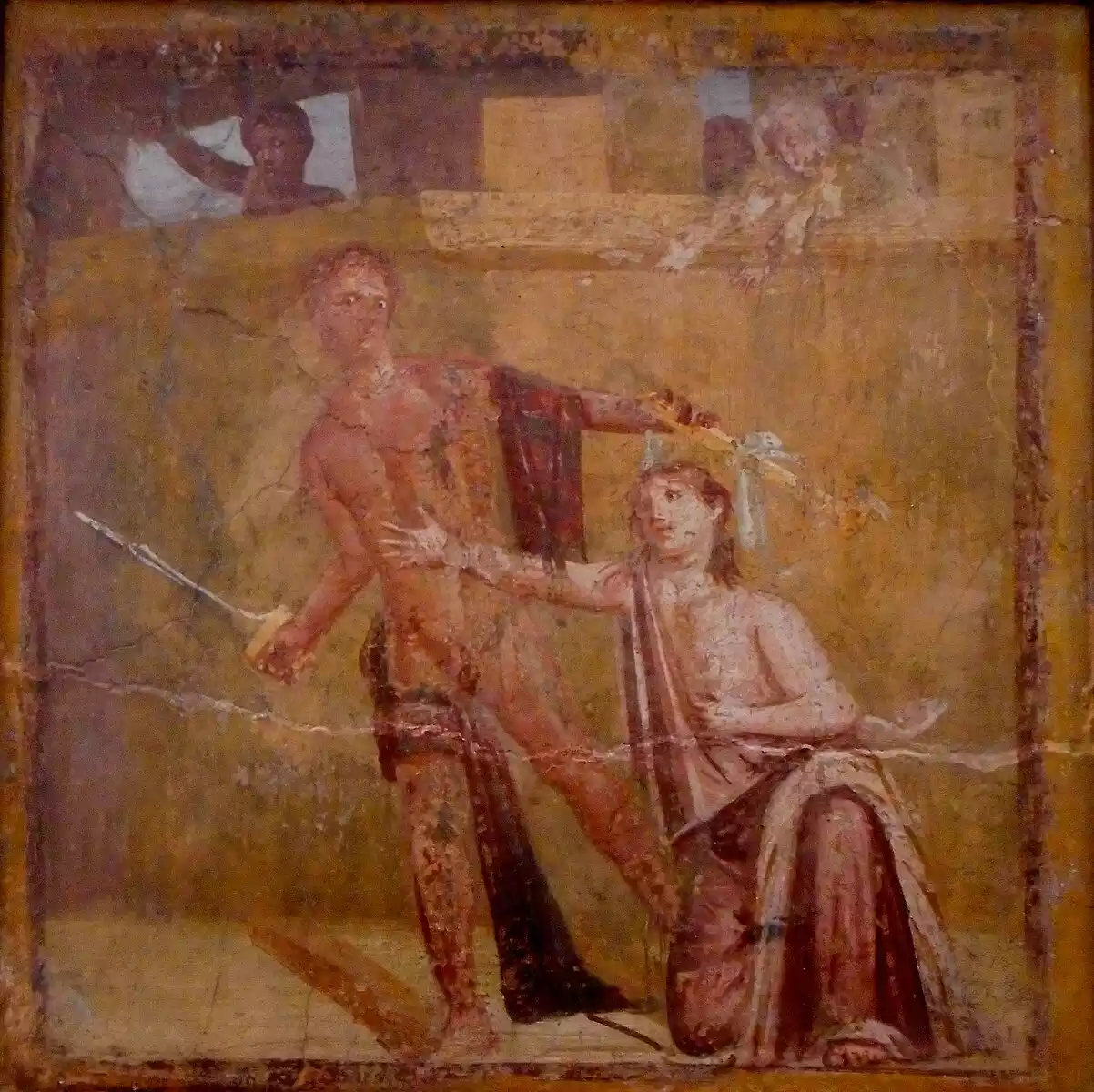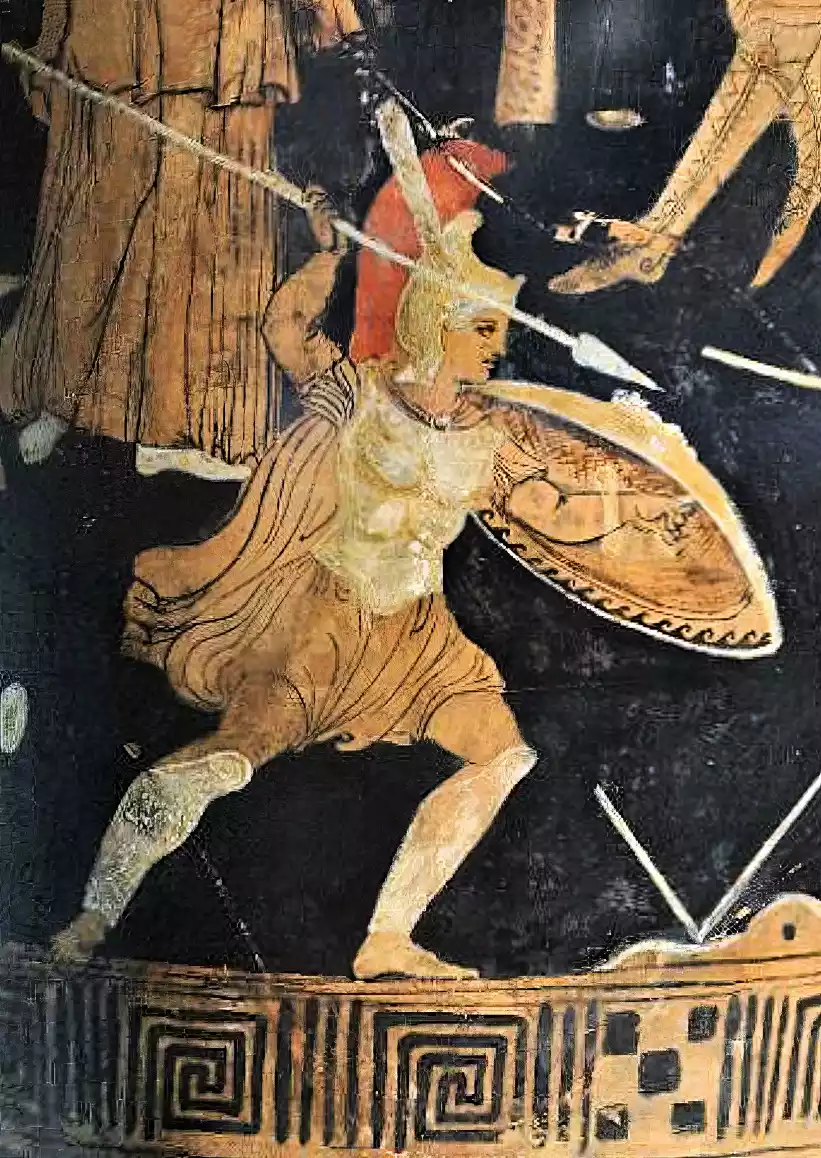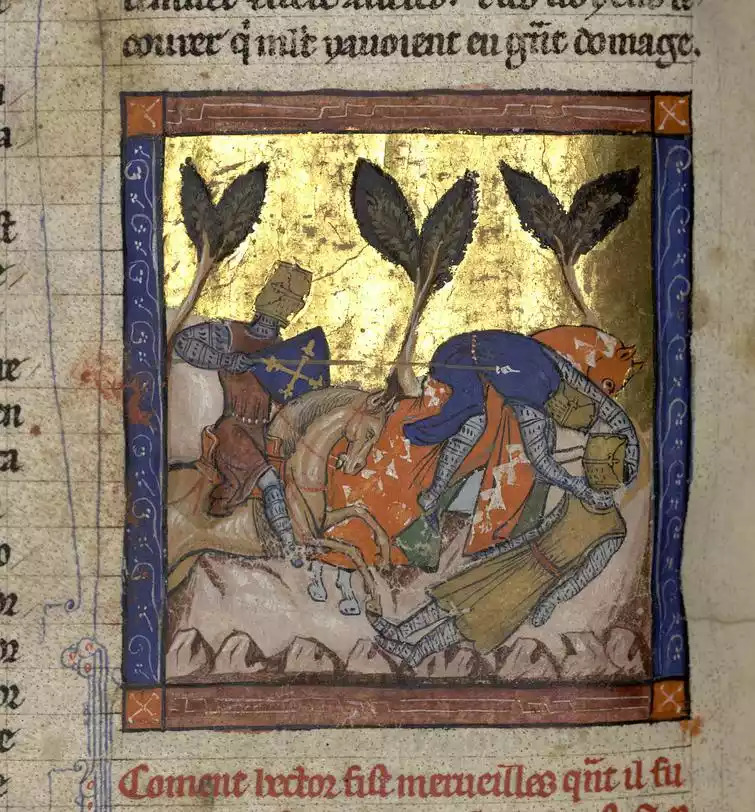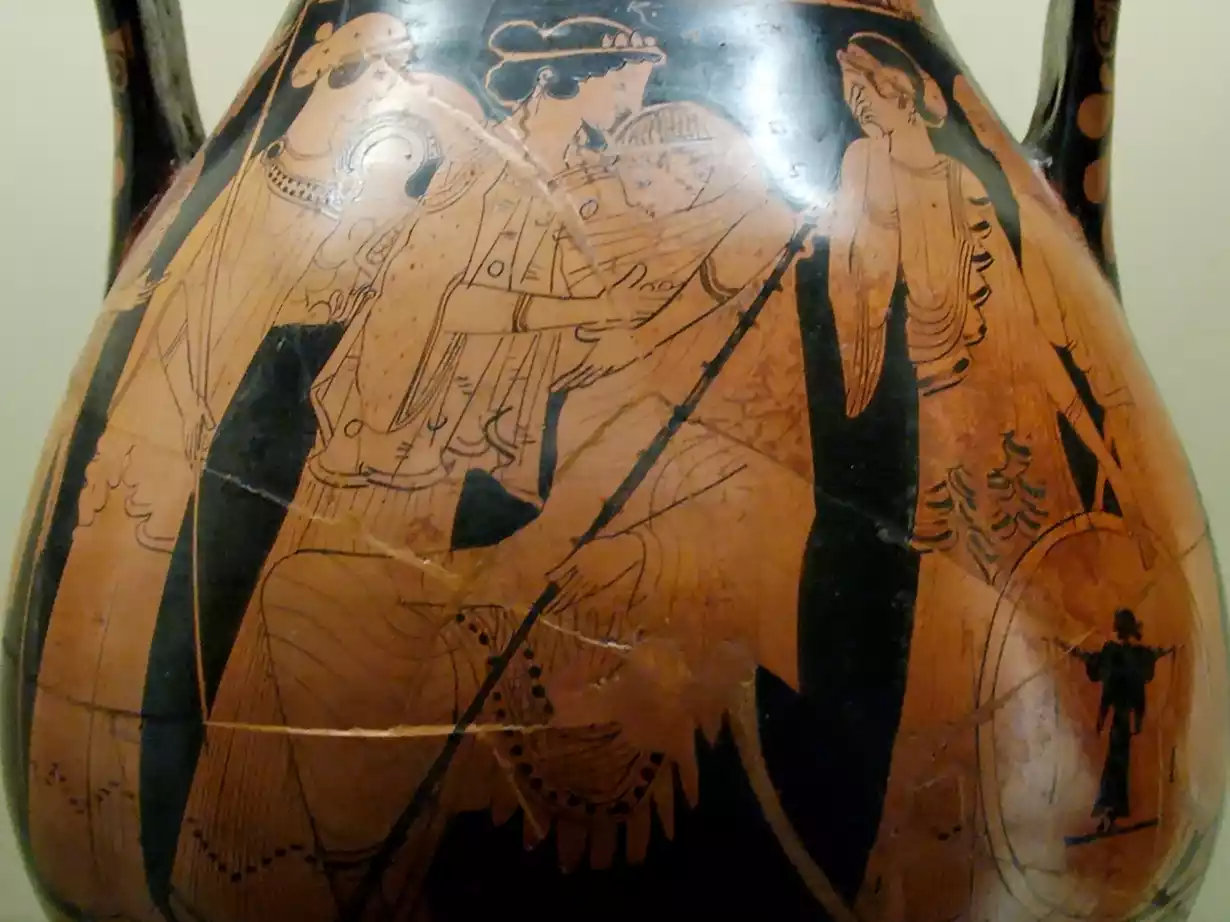
Attic black-figure hydria, ca. 575-550 BC. Thetis delivers the divine weapons to Achilles after the death of Patroclus, a turning point in the narrative about Patroclus and his friendship with Achilles. Louvre Museum (E869).
In the aftermath of the Trojan War, as masterfully woven by the Homeric epic, the Iliad, figures of heroes emerge who defined Greek mythology with their passions and deeds. Among them, Achilles stands out, the swift-footed, the invincible warrior, son of a goddess and a mortal, whose strength and rage drive the threads of the narrative. Beside him, however, stands an equally defining figure, often in the shadow of his glorious friend: Patroclus. The relationship between these two men, a deep and complex friendship forged on the battlefields and in their shared upbringing, constitutes one of the central pillars of the Iliad, giving the epic a profound human depth. The devotion, love, sacrifice, and heartbreak that accompany their fate resonate timelessly with the reader. Beyond the war cries and divine intervention, the story of Achilles and Patroclus is an ode to companionship, an exploration of the limits of human endurance and the pain of loss. The psychological unity that seems to pervade the two heroes within the framework of the Iliad is indicative of the depth of this bond (Stern-Gillet). Their relationship, after all, transcends simple friendship, touching the limits of an identification that would prove as defining as it is tragic (perhaps a reminder of the particular importance of friendship in the world of Homeric heroes). Let us unravel together the thread of this legendary friendship, exploring its roots, evolution, and catastrophic climax.
The Shared Upbringing and the Origins of the Bond
The story of the friendship between Achilles and Patroclus does not begin on the blood-soaked fields of Troy, but much earlier, in the years of innocence and apprenticeship. Although the sources differ in details, the prevailing tradition has Patroclus, son of Menoetius, finding refuge in the court of Peleus, Achilles’ father, in Phthia, after an involuntary murder he committed at a young age. There, under the protection of Peleus and the wise guidance of the centaur Chiron on Mount Pelion, the two young men grew up together, not merely as companions, but as brother souls. They shared the same teachings, from martial arts and hunting to music and medicine. This shared upbringing, far from the complexities of royal courts, laid the foundations for an unbreakable bond, a relationship of deep understanding and mutual respect that would withstand the trials of time and war. It was a formative period, where the bravery of Achilles coexisted with the noble and gentler nature of Patroclus, creating a dynamic balance that would characterize them in their adult lives.
Attic red-figure pelike, ca. 470 BC. Thetis comforts Achilles who mourns the death of his companion, while the Nereids bring the new weapons. The scene captures the agony, a central theme in the story about Patroclus and his friendship with Achilles. British Museum (E363).
Patroclus as Healer and Advisor
Beyond his undeniable bravery on the battlefield, Patroclus was distinguished for his kindness, compassion, and healing knowledge, traits that made him much more than a mere comrade in arms for Achilles. In the Iliad, Homer often presents him tending to the wounded Achaeans, using the skills he learned from Chiron. This quality of his as a healer also reflected his broader role as a moral supporter and trusted advisor to Achilles. In moments of doubt or rage of the great hero, Patroclus was often the voice of reason and moderation. He was the one who could approach the often irritable and absolute Achilles, soothe his anger, advise him, and even entertain him. Patroclus’ presence acted as a balancing factor in Achilles’ life, reminding him of his humanity amidst the turmoil of war. Even in the simplest moments, such as when he served wine to Achilles and his guests, their relationship maintained a special dynamic, even if sometimes there were moments when the more humble tasks displeased him (Iliff). This multifaceted nature of their relationship underscores the deep dependence and love that Achilles had for his companion.
The Fateful Decision: Achilles’ Armor
The most critical turning point in the story of their friendship, but also in the evolution of the Trojan War, comes when Achilles, clinging to his anger against Agamemnon, refuses to fight, allowing the Trojans under Hector’s leadership to reach the Achaeans’ ships. Seeing destruction approaching and his companions falling, Patroclus, with tears in his eyes, begs Achilles to let him enter the battle, wearing his divine armor. The idea was to inspire the Achaeans and terrify the Trojans, who would think that Achilles himself had returned to battle. Achilles, though hesitant, ultimately yields to the plea of his beloved friend. He gives him his armor, but with a clear instruction: to drive the Trojans away from the ships, but not to be carried away and pursue the enemy to the walls of Troy. This decision, born of desperation and love, seals Patroclus’ fate. The image of Patroclus wearing Achilles’ armor is one of the most powerful in the epics, a moment of supreme devotion but also tragic irony (Trypanis).

Roman fresco from the Vesuvius area, 1st century AD. The scene is interpreted as Thetis comforting the grieving Achilles, possibly for the loss of his friend, a theme related to Patroclus and his friendship with Achilles. Archaeological Museum of Naples.
The Battle and the Death of Patroclus
Wearing Achilles’ dazzling armor, Patroclus charges into battle like a raging lion. His mere presence rekindles the morale of the Achaeans and causes panic among the ranks of the Trojans. He leads the Myrmidons in a sweeping counterattack, driving the Trojans away from the ships and killing many brave warriors, including Sarpedon, son of Zeus. However, carried away by his battle frenzy (the “ate”) and forgetting Achilles’ warning, Patroclus pursues the Trojans to the city walls. There, fate catches up with him. The god Apollo, protector of the Trojans, strikes him in the back, stunning him and stripping him of his armor. Weakened and unprotected, he first receives the blow from the Dardanian Euphorbus and finally the fatal blow from Hector himself. The death of Patroclus is not merely the loss of a brave warrior, but a cosmic event that changes the course of the war and plunges Achilles into utter despair. The scene of the battle around Patroclus’ dead body is one of the most heartbreaking in the Iliad, with the Achaeans fighting fiercely to prevent his dishonor by the Trojans. His sacrifice becomes a symbol of supreme devotion, but also a tragic result of the transgression of the limits set for him.

Fresco from the François Tomb (Vulci, Etruria), ca. 350-330 BC. Depicts Achilles sacrificing Trojan captives in honor of his dead friend. The scene emphasizes extreme agony, an element of the narrative about Patroclus and his friendship with Achilles.
The Wrath and Revenge of Achilles
The news of Patroclus’ death reaches Achilles like a thunderbolt. His reaction is unprecedented in intensity and pain. The hero rolls on the ground, tears his clothes, mourns loudly, filling the air with cries of anguish that are heard to the depths of the sea, where his mother, Thetis, resides. The death of Patroclus acts as a catalyst, transforming Achilles. His previous anger (“menis”) against Agamemnon pales in comparison to the new, destructive rage that overtakes him, a rage now directed solely at Hector, the killer of his beloved friend. Achilles reconciles with Agamemnon, receives new, even more splendid armor from the god Hephaestus, and returns to battle, no longer for glory or honor, but for revenge. His fury is terrifying, spreading death and terror. The final duel with Hector and the desecration of his dead body reveal the depth of Achilles’ grief and vengeful fury. This revenge, however, also foreshadows his own end, as his fate was intertwined with that of Hector. The funeral of Patroclus, overseen by Achilles himself, becomes a grand ceremony, reflecting the royal stature he could have had, but also foreshadowing his own impending funeral, as the death of his friend exposes him to the same violence (Holway).
The Significance of Their Friendship in the Epic
The relationship between Achilles and Patroclus transcends the boundaries of simple martial companionship, forming the heart of the emotional and moral dimension of the Iliad. It is a friendship so strong that the death of one becomes the cause of the other’s destruction (Hofheinz, Mathwig, Zeindler). Through this relationship, Homer explores fundamental themes such as love, devotion, sacrifice, the pain of loss, rage, and revenge. Patroclus serves as the human counterbalance to Achilles’ almost divine nature, reminding him – and the readers – of the values of compassion, reason, and self-sacrifice. His death reveals Achilles’ vulnerability, not physically, but emotionally. Their friendship becomes the benchmark for all other relationships in the epic, and its tragic conclusion underscores the harshness and consequences of war. For the Ancient Greeks, this relationship served as a model of male friendship and devotion (although the exact nature of it has been a subject of discussion over the centuries). The story of Achilles and Patroclus remains a timeless symbol of the strength of human bonds, even amidst chaos and violence, rendering these two Homeric heroes immortal in collective memory (Albersmeier, Anderson).

Ancient Greek vase (Archaic period). Achilles faces Memnon. This battle follows the revenge for Hector’s death, showing the continuation of Achilles’ martial action, which was ignited by the loss of Patroclus and his friendship with Achilles.
Different Interpretations & Critical Assessment
The exact nature of the relationship between Achilles and Patroclus has been a subject of discussion and different interpretations for centuries, both in antiquity and in modern academic research. Some scholars, such as Holway, focus on the symbolic dimension, seeing Patroclus as Achilles’ alter ego, embodying aspects of heroism or his potential royal status. Others, following later ancient sources (such as Aeschylus or Plato in the “Symposium,” albeit with reservations), interpret their relationship as romantic, within the context of the social structures of ancient Greece. Researchers like Stern-Gillet emphasize the deep psychological unity and interdependence, without necessarily reaching a definitive conclusion about its romantic dimension, focusing on the concept of “friendship” as it is understood in the Homeric context. Modern approaches often recognize the complexity and intensity of the bond, avoiding simplistic categorizations and examining how this relationship functions dramatically and thematically within the Iliad.

Miniature from the manuscript “Histoire ancienne jusqu’à César” (Saint-Jean-d’Acre, ca. 1260-1270). Depicts Achilles killing Hector, an act of revenge for the death of his friend. The event concerns Patroclus and his friendship with Achilles. Bibliothèque municipale de Dijon (Ms 562)
Epilogue
The story of Achilles and Patroclus, woven with the threads of heroic friendship, devotion, and tragedy, resonates powerfully through the ages. More than a simple narrative of martial exploits, their relationship offers a profound insight into the human soul, the passions that drive it, and the consequences of its choices. The love that bound them, so strong that the death of one signifies the beginning of the end for the other, transforms the Homeric epic from a mere martial account into a timeless study of pain, rage, and redemption. Patroclus, with his kindness and self-sacrifice, and Achilles, with his overwhelming strength and unbearable grief, remain eternal symbols, not only of the heroic ideal but also of the complexity of human bonds. Their friendship, forged in the fire of war, continues to inspire, move, and provoke thought, reminding us of the indomitable power of love in the face of inevitable fate.
Frequently Asked Questions
Was Patroclus merely Achilles’ servant?
No, Patroclus was much more than a servant. In Greek mythology and the Iliad, he is presented as Achilles’ closest friend, companion in arms, healer, and advisor. They grew up together, and their relationship was characterized by deep devotion and mutual respect, far surpassing a simple master-servant relationship, touching the limits of brotherly love, if not something more, within the context of heroic friendship.
Why was Patroclus’ death so significant for Achilles?
The death of Patroclus marked a turning point for Achilles and the Iliad. The unbearable pain and rage over the loss of his most beloved person made him set aside his quarrel with Agamemnon and return to battle with the sole purpose of revenge. This loss revealed Achilles’ deep emotional dependence on his friend, shaping his subsequent actions.
What is the significance of Achilles’ armor in the story with Patroclus?
Achilles’ armor is a central symbol. When Patroclus wears it, he temporarily wins the battle, but at the same time seals his fate, as he violates Achilles’ command. The armor represents Achilles’ identity and strength, and its use by Patroclus underscores the tragic irony and the supreme devotion of their friendship within Greek mythology.
Is there consensus on the nature of the friendship between Achilles and Patroclus?
No, the exact nature of their relationship (friendly, romantic, a combination) has been a subject of discussion from antiquity to the present day. The Iliad emphasizes the deep love and devotion, characteristics of ideal heroic friendship. Later writers interpreted it as romantic, while modern scholars analyze the complexity of their bond within the context of the Homeric epic and Greek mythology, often avoiding absolute categorizations.
How did the friendship of Achilles and Patroclus influence the course of the Trojan War?
Their friendship significantly influenced the war. Achilles’ initial withdrawal due to his anger allowed the Trojans to gain ground. Patroclus’ decision to fight in Achilles’ armor temporarily turned the tide, but his death provoked Achilles’ uncontrollable rage, leading to Hector’s death and ultimately hastening Achilles’ own end.
Bibliography
- Albersmeier, Sabine, and Michael John Anderson, editors. Heroes: Mortals and Myths in Ancient Greece. Walters Art Museum, 2009.
- Georgiadis, Polis. Thucydides in Simple Greek for Simple People: 64 Lessons for Life from the Greatest Historian of Humanity. Kaktos Publications, 2021.
- Hofheinz, Marco, Frank Mathwig, and Matthias Zeindler, editors. Friendship: On the Relevance of a Time-Honored Concept. Theologischer Verlag Zürich, 2015.
- Holway, Richard. Becoming Achilles: Child-Sacrifice, War, and Misrule in the Iliad and Beyond. Lexington Books, 2012.
- Iliff, Glyn. The Shield of Achilles. Translated by Sofia Avgerinou, Psychogios Publications, 2015.
- Stern-Gillet, Suzanne. Aristotle’s Philosophy of Friendship. State University of New York Press, 1995.
- Trypanis, Kōnstantinos Athanasiou. Greek Poetry: From Homer to Seferis. University Press of Crete, 1986.


